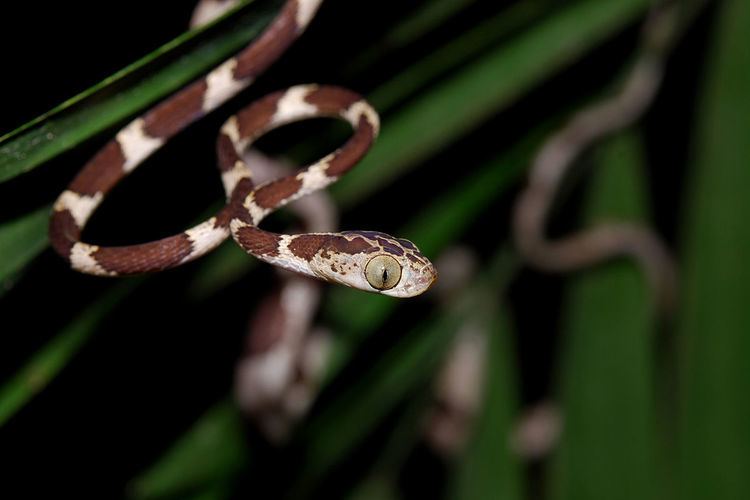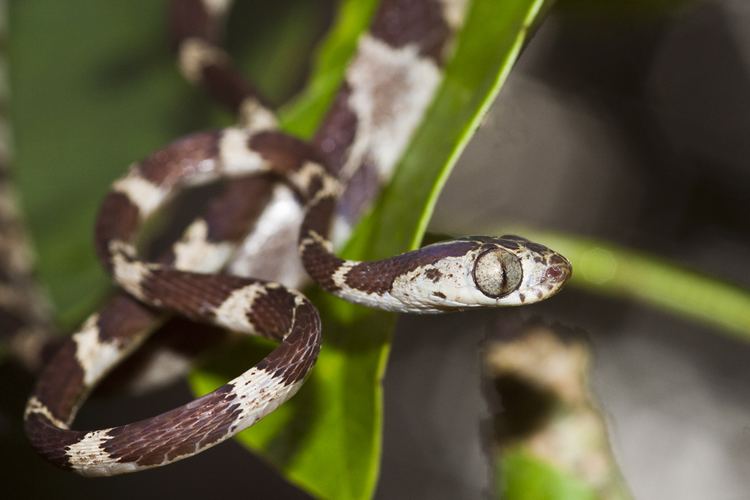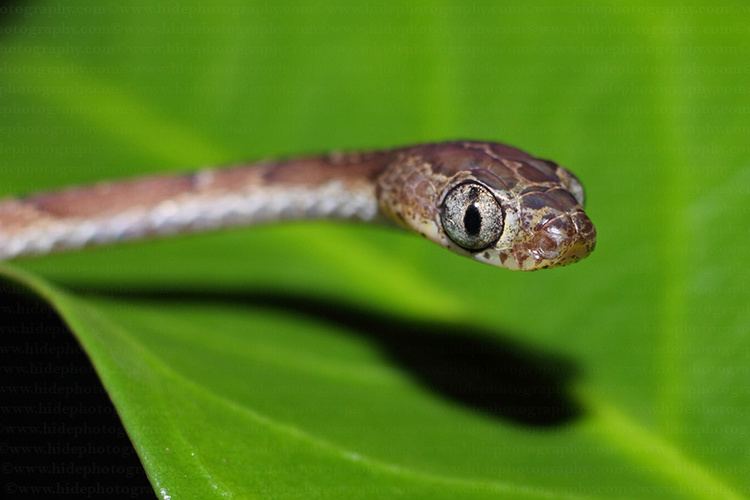Rank Species | Phylum Chordata Suborder Serpentes Genus Imantodes Higher classification Imantodes | |
 | ||
Similar Imantodes, Snake, Reptile, Leptodeira, Dipsas | ||
Snake wrangler terry blunt headed tree snake imantodes cenchoa
Imantodes cenchoa (common names: blunthead tree snake, fiddle-string snake, mapepire corde violon) is a species of rear-fanged colubrid snake distributed in Mexico, Central America, and South America.
Contents
- Snake wrangler terry blunt headed tree snake imantodes cenchoa
- Description
- Distribution and habitat
- Behavior
- Reproduction
- Diet
- References

Description
Blunthead tree snakes average about 800 mm (31 in). Maximum length is about 1.5 m (4 ft 11 in).

These snakes are known for their long, slender bodies and very large heads. Their pupils are very distinct from other snakes. Most snakes found around the world are known to have very poor vision and rely mostly on their smell and vibrations to detect signs of prey and predators. Arboreal snakes have much better vision among other classes of snakes. Blunthead tree snakes on the other hand, have vertical slits for pupils which allow for the snake to look down. This trait is what give the blunthead tree snake such an advantage over other snakes. Their eyes make up approximately 26% of its head.

The ventral surface, or stomach, of the snake is mostly white while the dorsal surface, or top, is a light or pale brown with lateral dark brown patches that begin at the head and continue down the length of the snakes’ body. The northern and southern populations of blunthead tree snakes exhibit different sexual dimorphism, the existence of two different traits of a species in the same population. For examples, northern males have a slightly longer tail whereas the southern populations have a smaller tail. In some regions females typically have a much larger head than the males.
Distribution and habitat

Blunthead tree snakes are arboreal. They are most often found in low vegetation such as coffee trees or bromeliads. These snakes prefer much cooler and moist areas such as wet forests and rainforests.

Blunthead tree snakes are distributed in Mexico, most of Central America, and parts of South America south to northernmost Argentina. Specifically, they have been recorded in eastern Mexico, Guatemala, Honduras, Belize, El Salvador, Nicaragua, Costa Rica, Panama, Colombia, Venezuela, Trinidad and Tobago, French Guiana, Brazil, Ecuador, Peru, Bolivia, Paraguay, and northern Argentina.
Behavior
Because the blunthead tree snakes are nocturnal, they can be found in a resting coiled position in very shaded areas during the day. At night they forage for food through dense vegetation on the ground up to their resting places in the trees.
Reproduction
Blunthead tree snakes are polygynandrous reptiles. Mating seasons can vary depending on the rainy seasons of their habitat. Some snakes mate year round while some snakes’ mating season may be synced with the wet and rainy seasons of their environment. For example, in areas with long rainy seasons these snakes tend to show a much longer mating season compared to snakes in areas with shorter rainy seasons. These snakes are oviparous or egg-laying animals that have little or no embryonic development within the mother. Some Blunthead tree snakes exhibit continuous reproduction depending on the environment that they live in. However, in an area that has seasonal rainfall, egg laying and hatching positively correlates with the rainy seasons. In Guatemala and Mexico for example, female snake lay their eggs between June and July. These eggs will hatch around July and August, which are the typically rainy seasons in these countries. On the other hand, snakes in Brazil exhibit continuous reproduction. The eggs are laid anywhere from November to January and start to hatch around March throughout August. Both male and female blunthead tree snake reach sexual maturity about 2 years after hatching or at around 620mm SVL (Snout-Vent Length). The female snake can have anywhere from one to three eggs, typically called a clutch, per breeding season depending on the size of the snake, its food habits, and environmental factors. Because these snakes are oviparous the female will leave her eggs after laying them. These animals do not present parental care traits.
Diet
Blunthead tree snakes are carnivores that forage primarily at night. They feed mostly on small lizards, frogs, and other reptile eggs. Because the female blunthead tree snakes tend to have larger heads, they are capable of preying on larger reptiles and amphibians. Blunthead tree snakes are rear-fanged and mildly venomous, but is not considered dangerous to humans.
